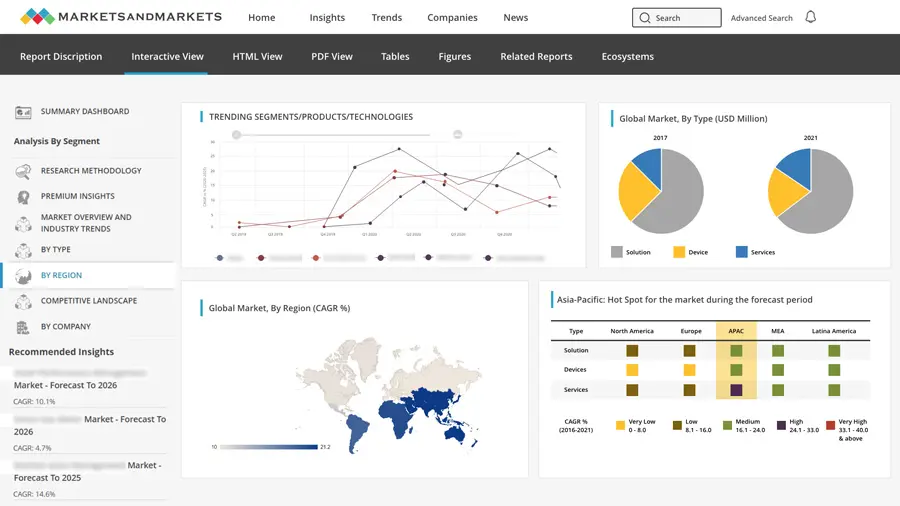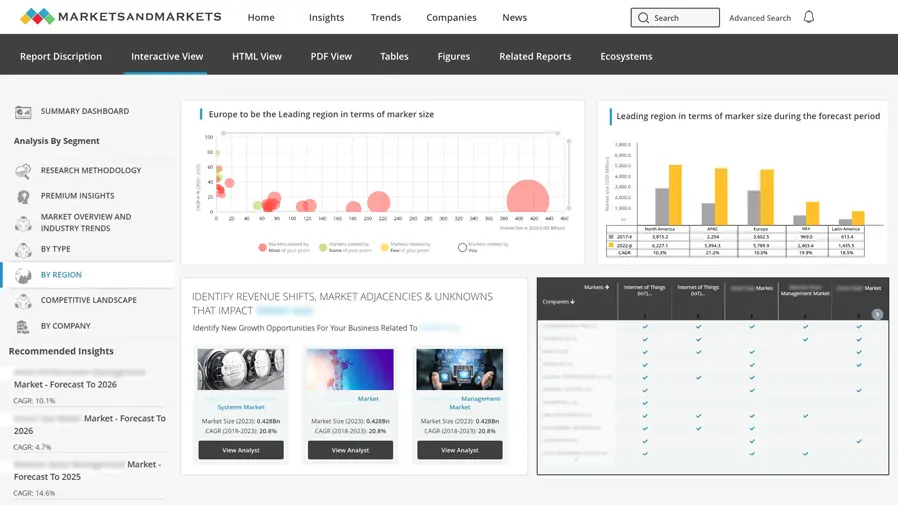Mammography Detector Market by type (analog and digital detectors) by technology (DC and IC detectors) by end-user (hospitals, diagnostic imaging centers, and others) and by Region - Global Forecast to 2030
The global mammography detector market has witnessed significant growth in recent years. Mammography detectors are key components used in mammography systems to capture and analyze breast images for the detection and diagnosis of breast cancer. This market research report provides a comprehensive analysis of the mammography detector market, including its current trends, market size, growth drivers, challenges, and future prospects.
The growth of the market is being driven by the increasing incidence of breast cancer, the rise in geriatric population, and proactive initiatives by healthcare organizations to raise awareness about early detection of breast cancer.
Market Drivers
- Increasing incidence of breast cancer: Breast cancer is the most common cancer among women, and the incidence of the disease is expected to increase in the coming years. This is a major driver for the mammography detector market, as mammography is the most effective way to screen for breast cancer in women without any symptoms.
- Rising awareness about the importance of early detection: There is a growing awareness about the importance of early detection of breast cancer. Early detection can improve the chances of survival, and this is driving the demand for mammography detectors.
- Technological advancements in mammography detectors: There have been significant technological advancements in mammography detectors in recent years. These advancements have led to improved image quality and diagnostic accuracy, which is driving the demand for mammography detectors.
Key Challenges
- High cost of mammography: Mammography is a relatively expensive procedure, and this can be a barrier to access for some women.
- Limited availability of mammography services: In some parts of the world, there is limited availability of mammography services. This can be a challenge for women who need to access mammography for early detection of breast cancer.
- Need for improved patient comfort: Mammography can be a uncomfortable procedure for some women. There is a need for improved patient comfort in order to increase the uptake of mammography.
Market Opportunities
- Growing demand for digital mammography: Digital mammography is becoming increasingly popular, as it offers improved image quality and diagnostic accuracy. This is an opportunity for the mammography detector market, as digital detectors are more expensive than analog detectors.
- Growth of the telemedicine market: The telemedicine market is growing rapidly, and this is an opportunity for the mammography detector market. Telemammography is the use of mammography to screen women remotely. This is a growing market, as it allows women to access mammography services in rural and underserved areas.
- Development of new technologies: There are a number of new technologies being developed for mammography, such as tomosynthesis and breast tomosynthesis. These technologies offer improved image quality and diagnostic accuracy, and they are an opportunity for the mammography detector market.
The direct conversion (DC) mammography detector segment is growing at the highest CAGR of the mammography detector market. This is due to the following factors:
- DC detectors offer better image quality and diagnostic accuracy than indirect conversion (IC) detectors.
- DC detectors are more cost-effective than IC detectors.
- DC detectors are more tolerant to high-dose radiation than IC detectors.
The hospitals segment holds the largest market share of the mammography detector market. This is due to the following factors:
- Hospitals are the primary providers of mammography services.
- Hospitals have the resources to invest in high-quality mammography detectors.
- Hospitals have a large patient volume, which drives demand for mammography detectors.
Asia-Pacific is the fastest-growing market for mammography detectors. This is due to the increasing incidence of breast cancer in the region, as well as the rising awareness about the importance of early detection.
Key Players
Some of the key players in the global mammography detector market include:
- Analogic Corporation
- Canon Medical Systems Corporation
- Fujifilm Holdings Corporation
- GE Healthcare
- Hologic, Inc.
- Siemens Healthineers
- PerkinElmer, Inc.
- Varian Medical Systems
Key Trends
The following are some of the key trends that are expected to shape the mammography detector market in the coming years:
- The increasing incidence of breast cancer: The increasing incidence of breast cancer is one of the key drivers of the mammography detector market. Breast cancer is the most common cancer among women, and the incidence of the disease is expected to increase in the coming years.
- The rising awareness about the importance of early detection: The rising awareness about the importance of early detection is another key driver of the mammography detector market. Early detection of breast cancer can improve the chances of survival.
- The technological advancements in mammography detectors: The technological advancements in mammography detectors are also expected to drive the growth of the market. Newer technologies, such as digital detectors, offer improved image quality and diagnostic accuracy.
Market Segmentation
The global mammography detector market is segmented by type, technology, end-user, and region.
- By type: The market is segmented into analog and digital detectors. Digital detectors are the most popular type of detector in the market, accounting for the majority of the market share.
- By technology: The market is segmented into direct conversion (DC) and indirect conversion (IC) detectors. DC detectors are the most common type of detector in the market, accounting for the majority of the market share.
- By end-user: The market is segmented into hospitals, diagnostic imaging centers, and others. Hospitals are the largest end-user of mammography detectors, accounting for the majority of the market share.
- By region: The market is segmented into North America, Europe, Asia-Pacific, Latin America, and Middle East & Africa. North America is the largest market for mammography detectors, followed by Europe and Asia-Pacific.
Frequently Asked Questions (FAQ):
What is a mammography detector?
A mammography detector is a device used in mammography systems to capture and analyze breast images. It plays a critical role in detecting and diagnosing breast cancer by providing high-quality images for radiologists to interpret.
What are the different types of mammography detectors?
The mammography detector market offers various types of detectors, including film-screen detectors, computed radiography (CR) detectors, and digital detectors (such as amorphous selenium and amorphous silicon detectors).
What are the key applications of mammography detectors?
Mammography detectors are primarily used in breast cancer screening, diagnosis, and monitoring. They help in the early detection of breast abnormalities, assisting healthcare professionals in making accurate diagnoses and facilitating effective treatment decisions.
What factors are driving the growth of the mammography detector market?
The mammography detector market is driven by factors such as the increasing prevalence of breast cancer, rising awareness about early detection, advancements in mammography technology, government initiatives for breast cancer screening programs, and growing investments in healthcare infrastructure.
Which regions are witnessing significant growth in the mammography detector market?
The mammography detector market is experiencing growth across regions, with North America, Europe, and Asia Pacific being the key regions. These regions have well-established healthcare systems, supportive reimbursement policies, and ongoing technological advancements in mammography technology.
What is the market size and growth rate of the mammography detector market?
The market size of the mammography detector market varies based on factors such as the region, type of detector, and market dynamics. The market has been experiencing steady growth, driven by technological advancements and increased emphasis on early detection of breast cancer.
What are the key trends in the mammography detector market?
Key trends in the mammography detector market include the shift from film-screen to digital detectors, the integration of artificial intelligence (AI) for image analysis, the development of portable and handheld detectors, and the emphasis on improving patient comfort during mammography procedures.
Are there any challenges faced by the mammography detector market?
The mammography detector market faces challenges such as high costs associated with digital detectors, concerns regarding radiation exposure during mammography, the need for skilled radiologists to interpret images accurately, and limited accessibility to mammography services in some regions.
What are the future prospects for the mammography detector market?
The future of the mammography detector market looks promising, driven by ongoing technological advancements, increasing adoption of digital mammography systems, the integration of AI for image analysis, and the potential for personalized and risk-based screening approaches.
Are there any regulations or standards governing the mammography detector market?
Yes, several regulatory bodies and organizations have established standards and guidelines for mammography systems and detectors, including the U.S. Food and Drug Administration (FDA) and the European Society of Breast Imaging (EUSOBI). These regulations ensure the safety and effectiveness of mammography devices and procedures.
To speak to our analyst for a discussion on the above findings, click Speak to Analyst
















Growth opportunities and latent adjacency in Mammography Detector Market